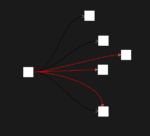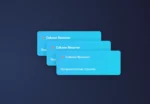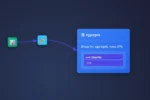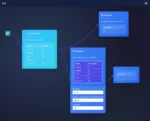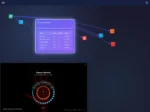
by tyler garrett | Jun 19, 2025 | Data Visual
In the ever-transforming landscape of cryptocurrency trading, Decentralized Finance (DeFi) has emerged as the most intriguing and impactful revolution yet. Unlike traditional financial systems, DeFi protocols are operated without intermediaries, governed instead by immutable smart contracts and decentralized decision-making. However, the complexity surrounding these systems often obscures actionable insights—from market trends to risk assessment. Because of this, traders, developers, and data-driven decision-makers increasingly rely on advanced visualization techniques to understand and leverage information transparently. In this blog post, we’ll dive deep into the significant role data visualization plays when analyzing DeFi protocols. We’ll unpack critical strategies, use cases, and spotlight innovative visualization techniques that clarify complexities, streamline decision-making, and give strategic clarity to investors and executives. As a leading software consulting firm specializing in data analytics and innovation, we share these insights to equip decision-makers with the tools and knowledge needed to harness data effectively to gain a competitive edge in cryptocurrency markets.
Why Visualization Matters in Cryptocurrency Trading and DeFi Protocol Analysis
The cryptocurrency market, particularly DeFi, is inherently volatile and fast-paced. Investors and decision-makers are often overwhelmed with data points, making timely assessments challenging without sophisticated forms of data representation. Effective visualization solves this by transforming complex, raw data into easy-to-understand visuals. Investors can then rapidly interpret changing trends, risk profiles, and emerging opportunities with clarity. For businesses and institutional investors, powerful visualizations provide strategic controls and insights, enabling faster and more informed decision-making processes.
DeFi protocols add further complexity due to varied mechanisms including liquidity pools, yield farming, decentralized exchanges, and smart contract operations. Each respective protocol demands careful analysis to guard against vulnerabilities and interpret financial opportunities. High-quality visualizations can depict relationships and sensitivities that raw data or spreadsheets may obscur. At data engineering consulting services, professionals assist clients in navigating these complexities through adept analytics and visualization solutions.
Additionally, visualization promotes transparency and helps communicate strategies clearly. Stakeholders and project participants appreciate the value generated from accessible dashboards and intuitive visual tools. An advanced, intuitive visualization dashboard not only saves time but allows trading strategies to adapt swiftly in rapidly changing market conditions. To illustrate further, our previous insights on cartogram implementations for geospatial data distortion clearly demonstrated how visual techniques can redefine analysis across industries, a lesson equally vital for the emerging DeFi space.
Building Strategic DeFi Dashboards: Design Principles and Best Practices
Establishing strategic dashboards for DeFi protocol analysis demands meticulous selection of visualization techniques and user-centric design principles. A well-designed dashboard should provide a clear, comprehensive view of relevant crypto market performance metrics such as liquidity, total value locked (TVL), price fluctuations, transaction volumes, and yield opportunities. Simplicity and intuitive layouts empower decision-makers to promptly analyze trends and performance indicators, accelerating informed decision-making.
Dashboards must also be agile, allowing quick adjustments for real-time market conditions. The principle of composability, popular within DeFi design itself, is particularly critical here. Similar to our earlier exploration of the composite pattern visualization framework for multi-metric analysis, effective DeFi dashboards can integrate multi-dimensional data sources seamlessly, creating cohesive narratives from disparate, real-time streaming data.
Adhering to best practices ensures measurable performance improvements and stakeholder satisfaction. At our firm, we effectively address these challenges by designing strategic dashboards focused on accuracy, clarity, and actionable insights. Our team regularly validates client dashboards, helping them overcome common mistakes that impair usability—as examined in our illuminating article discussing how auditing dashboards discovered common pitfalls.
The Role of Backpressure and Data Engineering in DeFi Protocol Visualization
The rapid rate at which crypto markets generate data presents unique engineering challenges—notably data overload impacting application responsiveness and analytical accuracy. As data volume and velocity escalate, DeFi visualization dashboards need sophisticated data engineering strategies for reliable real-time data processing. Implementing backpressure mechanisms in data streams is an essential solution that mitigates potential bottlenecks, safeguards against overflow issues, and enhances reliability.
Robust data engineering and backpressure solutions allow DeFi protocol analytics to remain accurate and functional under extreme data conditions, ensuring real-time data accuracy and system resilience. Our extensive experience offering data engineering consulting services in Austin, Texas positions our analysts uniquely to guide companies on navigating these complex challenges, ensuring reliability and uptime amid high-frequency data fluctuations that characterize DeFi markets.
Integrating robust data engineering practices with intuitive visual representations transforms how organizations address scalability challenges inherent in crypto trading platforms. Our previous exploration about scenarios where batch processing outperforms real-time analytics offers a strategic reference for finding a balanced, effective visualization strategy tailored to complex DeFi protocol analysis.
Semantic Layers and Data Governance: Clarifying Complex DeFi Concepts
Cryptocurrency trading can often be inundated with technical jargon and hard-to-understand terminology, obscuring understanding among business decision-makers. Implementing semantic layers greatly simplifies complex DeFi data interactions by translating technical terminology into straightforward, business-friendly language. Semantic layers ensure accuracy and consistency of business definitions across dashboards and analyses, enhancing overall data governance and democratization—topics explored in our previous insights about semantic layer implementation for business terminology.
Leveraging a semantic layer within DeFi analytic frameworks reduces confusion and aligns trading strategies effectively across teams. A strong semantic foundation also supports robust data governance guardrails, creating trust and transparency within cryptocurrency data insights. Thus, by mitigating ambiguity through structured semantics and visualization alignment, organizations foster confident, strategic decision-making throughout trading teams and executive leadership.
A robust data governance strategy leverages semantic layers to harmonize operations and improve analytical precision, which is paramount for rigorous DeFi protocol analysis and sustainable trading profitability.
Leveraging Visualization for Accurate Demand Prediction and Revenue Optimization
The predictive capabilities inherent in advanced visualizations, particularly when enhanced by machine learning and forecasting tools, offer critical competitive advantages in trading strategies. By effectively visualizing historical patterns, DeFi users and trading organizations gain powerful insights related to anticipated token demands, upcoming price rallies, liquidity crunches, and overall market sentiment.
This optimized forecasting process provides significant financial benefits through accurate demand prediction, highlighted previously in our analysis on precise forecasting unlocking business success. Accurate visual forecasting empowers business leaders to proactively address costly inefficiencies—a topic covered in detail in our article finding that 1% in your data that’s costing you 10% of revenue.
Strategizing around accurate visual forecasts allows organizations to optimize investment priorities and revenue streams by pinpointing and addressing minor issues before they escalate into significant losses. Coupled with visualization of trend predictions and actionable insights, data-driven decision-making can yield dramatically higher profitability and increased operational agility in the dynamic DeFi market.
Conclusion: Integrating Visualization Best Practices for Strategic Advantage in Cryptocurrency Trading
Success in cryptocurrency DeFi trading demands advanced data visualization strategies alongside robust data engineering, effective semantic layers, and accurate analytics for actionable insights. Dev3lop professional data engineering consulting helps navigate complexity through innovative technological approaches and advanced analytical processes, enabling informed decisions and greater profitability. Visual benchmarking and reporting tailored for DeFi empowers data-driven businesses to seize emerging opportunities proactively, leveraging informed strategies instead of reactionary responses. Adopt smart visualization today—transform obstacle into opportunity.
Thank you for your support, follow DEV3LOPCOM, LLC on LinkedIn and YouTube.

by tyler garrett | Jun 19, 2025 | Data Visual
The restaurant and food service industry is evolving rapidly, driven by growing consumer expectations, increased competition, and the quest to maximize profitability in an uncertain economy. To stay competitive, savvy restaurateurs and hospitality managers are increasingly relying on sophisticated digital tools, especially restaurant analytics dashboards. These dashboards consolidate complex data sets into interactive visuals that empower decision-makers to quickly uncover critical insights, optimize operations, and enhance customer experiences. By leveraging analytics tools designed to deliver strong ROI, managers can make informed, data-driven choices that directly impact revenues and operational efficiency. In this blog, we explore the strategic value of implementing restaurant analytics dashboards—from inventory and staffing optimization to advanced sales analytics like market basket analysis—helping stakeholders understand how innovative software and analytics techniques ensure sustained success and competitive advantage.
Understanding Restaurant Analytics Dashboards
At their core, restaurant analytics dashboards are centralized platforms that harmonize data collected from multiple restaurant function areas. From automated point-of-sale systems and inventory management applications to customer loyalty and reservation apps, these dashboards integrate diverse data flows into a coherent visual interface. Visualization is the critical component facilitating swift decision-making since it quickly conveys actionable information to non-technical stakeholders. The most effective dashboards commonly incorporate charts, graphs, dynamic filtering, and drill-down capabilities to allow business managers to navigate from high-level KPIs down to detailed transactional data effortlessly.
Implementing an effective dashboard solution requires strategic mastery over various components, including data ingestion, processing, and visualization. Employing techniques like advanced ETL (Extract, Transform, Load) consulting services ensures data pipelines are robust and optimized, guaranteeing consistency, accuracy, and compliance at every step of the analysis process. Combining powerful backend data processing technologies with seamless front-end visualization makes it easy for restaurant leaders to spot trends, manage inventory proactively, reduce costs, and enhance guest satisfaction.
A well-developed restaurant dashboard not only simplifies complex datasets but also creates intuitive pathways for actionable business insights that can be quickly applied to operational strategy and planning. Through innovative data narrative methods like scrollytelling visualization, executives and management teams can clearly communicate critical KPI storylines, enabling teams to easily understand complex scenarios and act decisively.
Key Insights Delivered by Restaurant Dashboards
The value of restaurant analytics dashboards lies primarily in their ability to uncover a wide array of insights crucial for operational optimization. For example, sales data can provide insights into best-performing dishes, emerging customer preferences, and even loss-leaders. Inventory data tightly integrated into dashboards enables proactive monitoring, preventing stock-outs, spoilage, and waste––significantly impacting margins. Labor and staffing analytics dashboards, meanwhile, can pinpoint optimal staffing levels, leading to more efficient shift scheduling and reduced labor costs.
Restaurant dashboards can harness advanced analytical techniques to provide deeper clarity into business performance. By incorporating predictive analytics and market-basket-analysis methods, dashboards reveal critical relationships and hidden insights among menu items. Utilizing specialized analytics techniques such as market basket analysis to identify complementary product pairings, restaurant owners can strategically upsell and refine menus to maximize average transaction totals.
Moreover, dashboards equipped with custom analytical models and algorithms can forecast future sales, detect seasonal patterns, and predict shifts in customer behavior, enabling managers to prepare effectively for different market conditions. Using these advanced forecasting mechanisms and visualization techniques, restaurant executives proactively minimize operational risks and improve sustainability in their day-to-day operations.
Best Practices for Dashboard Implementation in Restaurants
The effective implementation of restaurant analytics dashboards requires a strategic, multi-tiered approach. From data collection to final deployment, rigor and attention to detail significantly increase analytics effectiveness. Data quality and governance are foundational, necessitating clear rules, standards, and guidelines throughout the analytics life cycle. Implementing role-based data permissions and access controls ensures restaurant data remains secure and within regulatory compliance. Leveraging proven methodologies like carefully configuring database privileges, as explained comprehensively in our related guide on granting privileges and permissions in SQL, considerably reduces risks to data security while promoting efficient data-sharing practices within your organization.
When integrating disparate data sources, businesses must choose between centralized data storage or adopting innovative data architecture patterns for microservices. Microservices-driven data architectures enable agile decision-making by decentralizing data management, providing maximum flexibility for evolving operational requirements. Dashboards leveraging these optimization techniques frequently outperform conventional solutions, providing enhanced scalability, rapid deployment timelines, and reduced operational complexities.
Adopting complete data transparency is essential to dashboard success. Ensuring stakeholders understand the underlying metrics, clarity of visualization methods, and appropriate use of analytics fosters trust. Incorporating powerful and intuitive dashboards using tested methods such as precise SQL filtering techniques and visual layout optimizations arms decision-makers with effective insights, reducing confusion and increasing analytics utilization significantly.
Innovative Visualization Techniques that Drive Decision Making
To fully leverage dashboard capabilities, restaurant operators and executives must select visualization techniques with strategic intent—favoring clarity, simplicity, and storytelling potential. For hierarchical data sets, strategic use of treemap visualizations optimized for hierarchical representation present a clear hierarchy of menu popularity, order frequency, and product performance, enabling instant identification of top or underperforming menu items at a glance.
For networks and relationship mapping, employing powerful visualization methods like force-directed graphs for network data analytics uncovers subtle interdependencies and interactions, allowing restaurateurs to pinpoint high-value combinations, optimal recipes, or supplier dependencies. These relationships are traditionally hidden in numerical data sets but, through advanced visualizations, become immediately evident—leading to far superior strategic outcomes.
Further innovative techniques such as interactive dashboards incorporating intuitive drill-down capacities, visual forecasting charts, and KPI indicators allow users to adapt and interact dynamically with data. Smart targeting of data visualizations to specific user roles (e.g. operational management versus financial executives) ensures dashboards remain actionable, insightful, and highly relevant across your entire organizational hierarchy.
Selecting the Right Analytics Solution to Avoid Hype
Not all restaurant analytics dashboards are created equal—performance varies tremendously between solutions. Thus, restaurant executives should maintain a strong focus on practical functionality, scalability, ease-of-use, integration capability, and proven return on investment. Independently verifying and evaluating organized solutions and guidelines helps restaurant businesses avoid pitfalls associated with overhyped software. Investors and decision-makers can gain meaningful insights into overrated data engineering tools, allowing them to avoid expensive mistakes and choose effective analytics platforms that directly contribute to restaurant profitability and optimization goals.
Restaurants that choose mature dashboards incorporating proven analytics, visualization, and data engineering methodologies inevitably experience improved decision-making, reduced waste, increased revenue, and enhanced customer satisfaction. Strategic partnership with an experienced data analytics consulting service guarantees your dashboard investments fully support operational objectives and financial targets. A partnership approach ensures your restaurant always maintains technological leadership, optimizes costs, and continually learns and adapts from business insights generated.
Conclusion: Drive Restaurant Success through Analytics Dashboards
As restaurateurs increasingly rely on swift, analytical decision-making to achieve greater returns and optimize food service operations, restaurant analytics dashboards become vital enablers of success. Integrating rigorous data governance principles, innovative visualization methods, and advanced analytical capabilities positions restaurants to optimize workloads, reduce operating costs, and maintain unrivaled efficiency across their businesses. Ultimately, analytics dashboards help hospitality executives transform restaurant data into tangible operational improvements, fueling sustainable growth and long-term competitive advantage in today’s challenging industry landscape.
Thank you for your support, follow DEV3LOPCOM, LLC on LinkedIn and YouTube.

by tyler garrett | Jun 19, 2025 | Data Visual
Imagine a future where mental healthcare is data-informed, precise, and visually insightful. Where psychological progress isn’t just an abstract feeling but charted clearly in interactive visualizations and predictive analytics tools. From therapists juggling busy caseloads to healthcare organizations striving to improve treatment efficacy—mental health analytics solutions offer a new avenue for clarity and actionable insights. In this rapidly evolving digital age, data visualization shifts mental health outcomes from subjective assessments to meaningful, dynamic platforms—transforming how therapists understand, track, and enhance patient journeys. Let’s unwrap the potential power of advanced therapy outcome visualization systems and how leading-edge analytics techniques are reshaping mental healthcare.
Why Mental Health Analytics Matters in Modern Therapeutic Practice
In today’s digitally interconnected world, mental healthcare providers face mounting challenges in objectively measuring therapeutic outcomes. Typically, therapy involves numerous nuanced interactions and subtle psychological shifts difficult to quantify using traditional methods. Mental health analytics addresses these challenges head-on by offering systems that track patient progress, therapy effectiveness, and overall treatment impacts through intuitive visualizations. By leveraging specialized analytics tools such as Power BI consulting services, healthcare providers can shift from traditional pen-and-paper assessments to interactive, real-time outcome visualizations. This profound transformation grants practitioners the ability to quickly identify emerging patterns, gaps in treatment, and opportunities for intervention—ensuring quicker and more targeted therapeutic responses.
Mental health analytics solutions not only enhance the precision of assessments but also foster a shared understanding between patients and therapists through clearly rendered visual communications. Once hidden complexities become transparent with interactive dashboards that illustrate client progress, setbacks, and trends over time. Therapists gain the unprecedented ability to dissect and measure therapeutic efficacy visually, elevating mental healthcare from qualitative guesswork to substantive, quantitative evidence-backed methods. Applying enterprise-wide data type standardization frameworks, healthcare organizations can unify their analytic methods across diverse therapeutic approaches, creating consistency and contributing to successful outcomes.
Unlocking Insights with Advanced Visualization Techniques
One of the most potent aspects of mental health analytics is its capacity to leverage sophisticated visualization methods. Techniques such as radial visualization techniques for cyclical data patterns can precisely indicate recurring patient symptoms and demonstrate improvements over time—valuable for understanding conditions such as depression and anxiety with recurring episodes. Furthermore, specific visualization methods like ridgeline plots for distribution comparison allow therapists to compare a patient’s symptom severity before and after certain therapeutic interventions, enabling them to measure their effectiveness clearly and visually.
Additionally, integrating new principles like TL;DR – Win-the-MIN(1) paradigm for KPI charts allows mental health professionals to capture crucial performance indicators succinctly. Beyond traditional line or bar graphs, interactive therapies tracking dashboards make it possible to explore client data at both granular and aggregate levels. Users can zoom in on individual sessions for detailed analyses or zoom out to view complete treatment arcs, enabling therapists and decision-makers to quickly assess outcomes against organizational goals or clinical benchmarks. Leveraging advanced visual analytic techniques, clinics and counseling groups can easily detect subtle changes in patient responses, providing an exceptional level of detail unattainable via traditional assessments alone.
Data Governance and Privacy in Mental Health Visualization Systems
With great analytical power comes a crucial responsibility—data governance and client privacy protection. Mental health analytics systems must strictly adhere to established security standards and privacy liabilities. Techniques like privacy-preserving record linkage empower mental healthcare providers to integrate disparate datasets efficiently and securely, enhancing their analytical capabilities without compromising sensitive client information. Moreover, clearly defining the boundaries between data ownership vs data stewardship is critical in therapy visualization platforms to build trust among clients and maintain legal compliance with healthcare regulations like HIPAA and GDPR.
Given the sensitive and personal nature of mental health data, practitioners must use analytics carefully, maintaining transparency and accountability. Robust systems for consent management, data anonymity, and role-based access control should underpin any visualization solution. Healthcare organizations can create sustainable and trustworthy mental health analytics programs by proactively addressing these critical ethical and privacy concerns. Furthermore, it’s crucial to consistently purge obsolete or redundant data through processes designed specifically for evaluating and removing “zombie data.” Safeguarding patient anonymity across analytical reports promotes ongoing user trust and reliable therapeutic outcomes.
Leveraging Data-Lakes and Polymorphic Schema in Mental Health Analytics
An innovative mental health analytics system thrives on its ability to structure, manage, and handle diverse datasets efficiently. The future-proofing of such systems is significantly enhanced with advanced approaches like polymorphic schema handling in data-lake environments. Data lakes offer the flexibility and adaptability needed to accommodate therapy outcomes data coming from diverse sources—patient-generated content, clinician assessments, wearable health devices, or digitized safety-net conversations. By utilizing adaptable schemas, analytics platforms can integrate disparate datasets without compromising interpretability, scalability, or effectiveness.
Adopting polymorphic schema techniques enables mental healthcare providers to handle evolving data standards and necessitates compatibility within complex and multifaceted healthcare infrastructures. Coupling polymorphic schemas with flexible, adaptive visualization systems allows providers to keep pace with rapid changes in their data needs. It also facilitates nuanced, comprehensive analytical reports combining structured and unstructured data sources to paint a complete and transparent patient journey from diagnosis through follow-up care. Ultimately, deploying data lake solutions with polymorphic schemas enhances service personalization, risk assessment accuracy, and proactive interventions, transforming mental health outcomes visualization into a true strategic asset.
Into the Future: Hyperdimensional Computing and Predictive Mental Health Analytics
The horizons of mental health analytics are broadening. Advanced new techniques like hyperdimensional computing approaches to analytics promise significant leaps forward in predictive capabilities. Hyperdimensional computing processes high-dimensional data, enabling the rapid recognition of subtle mental health issues and treatment responses that traditional analytics might overlook. These advanced methodologies offer significant potential in predictive modeling—healthcare providers can better anticipate client needs, proactively intervene to reduce treatment interruptions or relapses, and forecast patient outcomes with precision.
Imagine the advantage therapists gain by incorporating real-time predictive analytics into visualization dashboard interfaces—making data-driven therapy plans increasingly responsive to client needs. Hyperdimensional computing allows for scalable big-data processing, swiftly identifying correlations and hidden patterns within massive amounts of complex therapeutic data. Mental health providers will be empowered to gain insights well beyond traditional methods—moving beyond surface-level insights toward sophisticated predictive analytics and transformational therapeutic impacts in entirely unforeseen ways.
Conclusion: Setting a New Standard for Therapy Outcomes
Mental health analytics and therapy outcome visualization systems are positioned to redefine the landscape of psychological care entirely. Therapists and mental healthcare organizations empowered by advanced visualization technologies have richer insights, leading to improved interventions, better patient engagement, and more measurable outcomes. By intelligently utilizing analytics, implementing robust data governance, leveraging adaptable data-lake technologies, and embracing predictive analytics, tomorrow’s mental health leaders can deliver more precise, targeted, and effective care than ever before.
The pioneers in this innovative space are not just improving mental health—they’re redefining how we think about therapy’s effectiveness and outcome management today and in the future. This analytics-focused evolution in mental healthcare is not merely theoretical—it’s already underway. Now is the time to engage reliable analytical expertise and consultancy, adopt breakthrough analytics approaches, and redefine your therapeutic strategies to secure healthier outcomes for clients and greater success for your practice.
Thank you for your support, follow DEV3LOPCOM, LLC on LinkedIn and YouTube.

by tyler garrett | Jun 19, 2025 | Data Visual
Picture a world where your brand anticipates fashion trends months before they become mainstream—where your business decisions are driven not by guesswork, but by rich visualizations of detailed analytics. Fashion analytics, powered by innovative data visualization platforms, is changing the playing field. Businesses can now capture consumer preferences with unmatched precision and deliver personalized experiences at scale. In the fast-paced, competitive fashion industry, understanding and visualizing the right data can mean the difference between leading the market or falling behind. Let’s explore how visualization technology powered by cutting-edge analytics can propel your fashion brand forward into an era of smarter, data-driven decision making.
The Power of Predictive Analytics in Fashion
Predictive analytics has redefined traditional forecasting methodologies, leveraging vast volumes of data—from historical sales figures to social media trends—bringing unprecedented clarity to future product demands. By identifying purchasing behavior patterns, style shifts, and emerging consumer preferences, predictive analytics helps fashion brands stay proactive rather than reactive. Leveraging robust data pipelines, like those discussed in our blog article Data Pipeline Dependency Resolution and Scheduling, organizations can ensure accurate, timely data processing. Coupled with scalable data solutions such as Data Lake vs Data Warehouse architectures, brands gain the agility needed for rapid trend identification and iterative decision-making.
High-performing prediction models are not just beneficial for inventory optimization; they directly influence profitability and customer satisfaction. Accurate trend prediction minimizes excess stock, reduces markdowns, and improves customer loyalty by ensuring popular items remain in stock. Analytics-driven inventory management allows fashion retailers to target the right customers with the right products, ensuring a seamless consumer experience and delivering a critical competitive advantage.
Through sophisticated analytical platforms that integrate seamlessly with internal business systems, fashion brands achieve granular insights into customer preferences and behavioural shifts. Strong data governance protocols, as illustrated in our comprehensive guide on Data Governance Practices, ensure robust quality and consistency of data, maximizing the return on predictive analytics investments.
Visualizing Fashion Trends for Actionable Insights
Visual analytics platforms are revolutionizing how fashion organizations interpret and action their accumulated data points. By translating complex datasets into intuitive, interactive dashboards, stakeholders can quickly assess market landscapes and respond dynamically to emerging trends. Platforms that emphasize usability and readability are particularly critical for time-sensitive industries like fashion. For stakeholders seeking to enhance data interaction efficiency, exploring Non-Blocking Data Loading Patterns for Interactive Dashboards provides an excellent foundation for delivering responsive, user-centric visualization experiences.
Fashion analytics dashboards, equipped with visual tools such as market heatmaps, seasonal consumption patterns, or region-specific purchasing trends, empower decision-makers to derive actionable insights effortlessly. Visualization solutions can even incorporate advanced techniques like Market Basket Analysis, which we unpack in depth in our article on The Art of Upselling, helping fashion retailers quickly identify complementary products to drive higher zipper sales, stronger upselling tactics, and deeper consumer loyalty.
Accessible visualization platforms are also essential for inclusive analytics adoption across organizations. As recommended in our strategic overview on Designing Accessible Visualizations for Screen Readers, ensuring tools remain accessible for all stakeholders promotes widespread collaboration and better decision-making processes, creating widespread awareness and literacy of powerful data-driven insights across an organization.
Harnessing Real-Time Data Through Innovative Platforms
As fashion cycles grow increasingly shorter, staying ahead demands more than traditional monthly or seasonal insights. Emerging fashion analytics platforms offer real-time analysis capabilities, providing instant feedback loops that empower prompt and informed decisions. Node.js, a powerful open-source JavaScript runtime environment, has emerged as the powerhouse behind many real-time visualization platforms. To find out why Node.js is ideal for developing scalable real-time analytics applications, our expert Node.js Consulting Services provide tailored strategic solutions and highlight business-enhancing use cases.
These real-time capabilities not only make analytics insights actionable immediately but also bring increased flexibility and responsiveness to market fluctuations. Innovative software platforms utilizing real-time data analytics continually update visualization dashboards, ensuring supply chain, marketing, and product development teams stay aligned and prepared for rapid pivots. Efficiently retrieving up-to-date data is also critical—a method you can explore further in our article about Utilizing the SELECT TOP Statement in SQL. Such strategies effectively facilitate swift, precise retrieval of insights without lag or obstruction, improving your organization’s edge in the saturated fashion market.
Fashion brands that leverage responsive analytics dashboards powered by real-time data ensure business agility, risk mitigation, and operational resilience. As technology continues to evolve, the significance of real-time, visually intuitive analytics visualization platforms in maintaining market competitiveness grows exponentially.
The Critical Role of Optimized Experimentation and A/B Testing
The effective integration of experimentation approaches, particularly leveraging A/B testing, is essential to developing insights into consumer preferences and trend patterns. In our detailed article, The Science of Optimization: How A/B Testing Can Improve Your Business, we highlight how thoughtful experimentation enables fashion brands to make data-driven design decisions optimizing products and marketing strategies for maximum consumer response.
A rigorous approach to experimentation analytics allows companies to fine-tune campaigns, products, styles, color choices, pricing strategies, and customer engagement tactics. These experiments can produce visual data insights directly integrating into overarching analytic dashboards, allowing stakeholders to rapidly visualize the ROI and iteratively refine initiatives.
Moreover, leveraging experimentation analytics also deepens organizational understanding of consumer sentiment and expectation. Real-world consumer data from A/B tests reveal valuable insights beyond quantitative purchase metrics, fostering more precise segmentation and personalization practices crucial to fashion industry success.
Data-Driven Sustainability in Fashion Analytics
Fashion has a considerable environmental impact, growing pressure exists from consumers for brands to demonstrate commitment to sustainability. Analytics platform utilization significantly improves fashion retailers’ ability to plan responsibly, minimizing textile waste through precise inventory management. Detailed visualizations illuminate patterns leading to overproduction and unsold merchandise, enabling eco-friendly inventory adjustments and more accurate forecasting.
Data analytics also identifies sustainable materials preferences and quantifies their appeal across fashion consumer segments. By enriching consumer-driven data visualizations through accurately segmented analytics, organizations can proactively pivot towards greener designs and production cycles without sacrificing consumer choice or profitability.
Analytics tools also offer compelling opportunities for addressing societal issues within fashion commerce. The power that data analytics has in influencing positive societal change can be seen in our article, The Role of Data Analytics in Addressing Austin’s Housing Affordability Crisis. Similarly, by embracing analytics capabilities, fashion industry leaders drive meaningful outcomes around sustainable fashion practices, cost-efficient production methods, and consumer-satisfying inventory choices.
The Future of Fashion Analytics: Data Management Best Practices
The rapidly accelerating dependence of the fashion industry on analytics-driven decision-making underscores the importance of strong data management practices. As we emphasize in our analysis of Application Data Management vs Enterprise Data Management, understanding which strategies best fit your organization’s scale and maturity encourages scalable growth and ensures sustained analytics reliability.
Effective data strategy decisions—such as deciding between cloud, hybrid, or onsite solutions, choosing suitable storage technology, establishing comprehensive governance frameworks, or advancing integration with machine-learning models—all reflect key strategic analytics considerations ultimately determining success in fashion-trend visualization platforms. Strong foundations in data management, governance, and structured analytics enable confident application of trend prediction and optimization models.
Ultimately, forward-looking fashion companies embracing visualization platforms providing insights rooted in reliable database management will consistently outperform less data-savvy competitors. Investing in powerful, scalable, and innovative analytics visualization platforms will not only enhance predictive capabilities but also solidify long-term market leadership, transforming your fashion brand into an agile, customer-focused industry trend-setter.
Thank you for your support, follow DEV3LOPCOM, LLC on LinkedIn and YouTube.

by tyler garrett | Jun 18, 2025 | Data Processing
The digital era has ushered in enormous volumes of data, pulsating through the veins of modern organizations as the lifeblood of informed decision-making. Yet not all data shares an equal weight—some is rich with actionable insights, while other datasets offer little more than background noise. As data experts, we recognize central measures capable of discerning this critical difference through advanced analytical methods. One such measure is entropy metrics—a powerful tool for quantifying information content within datasets. By grasping what entropy metrics entail and applying them strategically, organizations can focus their analytical capacities precisely where it counts, fostering true innovation and maintaining agility in today’s fast-paced market landscape. In this article, we’ll demystify entropy metrics, illuminate their strategic roles, and explore practical methods for integrating them into your analytics workflow.
What Are Entropy Metrics?
Entropy metrics originate from information theory—a mathematical field dedicated to quantifying and communicating information. In essence, entropy provides a numerical measure of uncertainty or randomness within data. High entropy indicates greater unpredictability and variability, signifying abundant informational value. Conversely, datasets exhibiting lower entropy possess more predictability; while they may seem useful due to their stability, they could potentially indicate redundancy or limited capacity for revealing novel insights.
To illustrate this: consider an overly predictable dataset containing repeated values or structured, monotonous entries. Its entropy metric would approach a near-zero value, signifying the absence of meaningful diversity. In contrast, highly dynamic, unpredictable datasets with varied contents and complex interactions return high entropy values, indicating a wealth of informational potential awaiting further analysis.
When adopting entropy analyses into real-world data management practices, understanding variability serves as the cornerstone. This approach not only helps prioritize resource allocation for maximal impact but also facilitates optimized data transformation by applying strategic techniques like just-in-time transformation.
Why Entropy Metrics Are Crucial in Today’s Landscape
In our era of big data analytics and hyper-scale computing environments, decision-makers strive to distill clarity from massive data streams. Organizations frequently find themselves overwhelmed, mistakenly assuming every byte of captured data contains indispensable intelligence. In reality, extracting insightful intelligence hinges strongly upon distinguishing relevant information from extraneous noise.
Entropy metrics allow organizations to efficiently pinpoint high-value datasets for deeper analysis, safeguarding analytical resources, such as computational bandwidth and human capital, from wasteful processing. For example, industries facing potential fraud and security threats benefit significantly by employing entropy analyses to highlight sudden shifts or irregularities. Integrating entropy measurements complements advanced strategies—such as real-time monitoring and early alert systems—addressed in our article covering methods of stopping fraudulent activity before it happens.
Especially significant for financial companies inundated with data, entropy metrics can help leadership circumvent pitfalls detailed in our discussion of finance industry data over-reliance. By identifying data sets of greatest value within massive transaction records or customer activity logs, financial institutions can steer clear from unproductive analytical paths, focusing critical attention solely where actionable insights can emerge.
Applying Entropy Metrics: Techniques and Practical Examples
Entropy calculations rely heavily on probability distributions across dataset values. One sophisticated yet accessible entropy metric is Shannon entropy, which quantifies the unpredictability associated with variable values. For textual data, this might involve analyzing the frequency of certain words or characters; for numerical data, entropy calculations often focus on variable probability distributions and patterns within continuous or categorical data.
In practice, advanced analytics teams integrate entropy analyses alongside automated workflows to continuously assess data quality, structural soundness, and consistency. Take data integration efforts, which benefit significantly as greater entropy in data dimensions may indicate potential inconformity or merging challenges. Professionals can proactively address these issues through techniques discussed in our overview of dimension conformity enforcement, allowing organizations to enhance trustworthiness and consistency in their integrated datasets.
Similarly, when dealing with file-based data such as CSV files, entropy metrics quickly expose files with severe encoding or formatting issues. Organizations that follow our strategies on handling dirty CSV files and encoding issues find it beneficial to implement entropy indicators on incoming files. These indicators serve as potential criteria for flagging needed corrective interventions, reducing downstream risk and complexity.
Entropy as a Pillar of Data Security and Integrity
An important strategic consideration is utilizing entropy metrics as part of broader information security and integrity frameworks. Entropy assessments naturally align with discovery efforts intended to highlight sensitive information and data elements holding strategic importance. Datasets registering unusually high entropy levels could indicate heightened sensitivity and the presence of personally identifiable information (PII), which should be governed stringently using practices explained in our guide on automated data sensitivity classification using machine learning.
In addition, entropy metrics critically support cryptographic and hashing applications. Security methodologies frequently draw on entropy measures to establish robust randomness standards in cryptographic keys and to validate data fingerprints against tampering. Our insight into fingerprints and checksums as methods for ensuring data integrity underscores the crucial role entropy plays in preventing data breaches and securing assets within modern organizational settings.
Employing entropy indicators in conjunction with dynamic access control mechanisms, such as discussed in our article on dynamic data masking for role-based data access, ensures that information variability is tightly controlled, helping organizations meet stringent compliance guidelines and mitigate cybersecurity vulnerabilities proactively.
Turning Entropy Metrics into Strategic Advantage
Realizing strategic advantage from entropy metrics requires embedding them at the core of your analytical pipeline. Organizations typically begin with targeted baseline measurements, establishing normal entropy levels for different categories of data. Over time, deviations or fluctuations in these established entropy baselines signal emerging patterns, alerting analysts to investigate further.
Additionally, visualizing entropy metrics can be vital for clear communication across teams and stakeholders. Effective visualizations highlight entropy variations, exposing patterns typically invisible to manual inspection. To master the creation of such intuitive, impactful visuals, review our recommended guidelines in the article detailing ten tips for creating effective data visualizations. Investments in visualization translate entropy measurements from abstract statistical concepts into tangible, actionable images, accelerating informed decisions among leadership and technical teams alike.
Moreover, firms utilizing integrated data solutions—for instance, Procore’s comprehensive data resources—should consider incorporating entropy analyses into their API design practices to gain even deeper insights. Firms seeking assistance integrating Procore into their analytical stack can directly benefit from our specialized Procore API consulting services.
Conclusion: Harnessing Entropy Metrics for Information Mastery
In the realm of big data analytics, entropy metrics stand out as practical, strategic measures empowering businesses to prioritize analysis, enhance data integration, enforce effective data governance, and secure their most vulnerable organizational assets. Understanding entropy doesn’t just bring clarity to your datasets—it paves new pathways to advanced analytics, predictive intelligence, and strategic foresight. Embrace entropy measurements to maintain confidence in decision-making and gain a competitive edge in today’s information-driven market.
At Dev3lop, our passion centers around fostering your organization’s analytic excellence. Whether you’re facing challenges in data integrity, sensitivity, visualization strategies, or integration complexities—entropy metrics offer clarity amidst chaos. Let these powerful tools help shape your future-ready organization through decisive insights and ongoing innovation.
Tags: Entropy Metrics, Data Analytics, Data Integration, Information Theory, Data Security, Strategic Data Management






